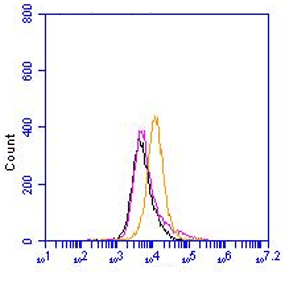CD166, Human, mAb AZN-L50
€133.00 – €1,245.00
The monoclonal antibody AZN-L50 recognizes activated leukocyte cell adhesion molecule (ALCAM), a member of the immunoglobulin superfamily and has a characteristic VVC2C2C2 domain structure. ALCAM is a type I transmembrane protein of 100 kDa with five extracellular immunoglobulin-like domains and a short cytoplasmic tail. ALCAM mediates homotypic ALCAM-ALCAM interactions and heterotypic interactions with the T-cell antigen CD6. Homotypic interactions are involved in the development and maintenance of tissue architecture and tumor progression. Heterotypic interactions initiate and stabilize T-cell-dendritic interactions affecting T-cell activation.
ALCAM is secreted as a NH2-terminal fragment of 30 kD. Soluble ALCAM (sALCAM) induces divergent biological signals and responses.
ALCAM shows a characteristic, temporal and spatial distribution in development of a wide variety of tissues and cells in health and disease. ALCAM is expressed on a wide variety of cells, within the leukocyte population its expression is particularly high on dentritic cells. ALCAM is involved in various physiological processes including hematopoieses, thymus development, the immune response, neurite extension, neural cell migration, embryogenesis, neurogenesis, angiogenesis, osteogenesis and is a marker for pluripotent mesenchymal stem cells.
The monoclonal antibody AZN-L50 completely blocks homophilic ALCAM-ALCAM interaction.
FC: Antibody AZN-L50 stains the extracellular domain of ALCAM. K562 cells (2x105) were stained with 4 µg/ml antibody.
FS: Antibody AZN-L50 functions as an blocking antibody for homotypic ALCAM-ALCAM interaction.
IF: Antibody AZN-L50 (4 µg/ml) was used on methanol/acetone fixed monolayers of cells grown on a glass surface.
IP: Radioactive labelled KG1a cells were lysed and precipitated with 1 µg of antibody coupled to Protein G Sepharose 4 Fast Flow beads.
IHC-P: Tissue sections were pretreated by heating in a rice steamer in citrate buffer for 10 minutes for antigen retrieval. Tissue sections were blocked with normal horse serum.
W: A non-reduced sample treatment and 6,5 % SDS-Page was used. The mature protein has a band size of 100 kDa and the soluble form 30 kDa.






